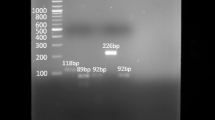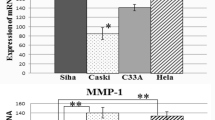Abstract
Invasive breast cancer varies widely in biologic aggressiveness, from fairly indolent tumors to rapidly disseminating carcinomas. Matrix metalloproteinases have enzymatic activity and assist in tumor invasion by degrading basement membranes and extracellular matrix. The extracellular matrix metalloproteinase inducer EMMPRIN is thought to stimulate fibroblasts to produce the zymogen pro-gelatinase A. The membrane type 1-matrix metalloproteinase (MT1-MMP) is thought to assist in tumor invasion and metastasis by activating pro-gelatinase A, which shows enhanced expression in various tumors. Overexpression of gelatinase A has shown to correlate with a malignant phenotype in many tumor forms. The aim of the study was to investigate the mRNA expression pattern of MT1-MMP, gelatinase A, and EMMPRIN in breast tumors. Formalin-fixed paraffin-embedded breast tissue samples from 18 patients operated on with breast-conserving surgery for invasive breast carcinoma <20 mm between 1977 and 1985 were analyzed using the mRNA in situ hybridization technique. Most of the patients were node-negative (15/18) and underwent postoperative irradiation to the breast (16/18). The median age at diagnosis was 52 years (21–83 years). At the time of the study 11 patients were alive, 4 without recurrence; 7 patients had been operated for ipsilateral breast tumor recurrences, and 2 had distant metastases. The median follow-up was 112 months (102–193 months). Seven patients died of disseminated breast cancer; their median follow-up was 43 months (22–116 months). 35S-labeled antisense and sense mRNA probes transcribed from linearized plasmids containing cDNA for the matrix metalloproteinases gelatinase A and MT1-MMP and the glycoprotein EMMPRIN were hybridized to 5 μm paraffin-embedded tissue sections. Several invasive carcinomas were surrounded by normal tissue and carcinoma in situ lesions. Gelatinase A, MT1-MMP, and EMMPRIN mRNA expression were detected in all of the carcinomas. The gelatinase A mRNA expression was mainly localized to stromal cells at moderate to high levels surrounding the invading carcinoma cells but was also seen in single cells at low levels in in situ lesions and in some normal glandular cells. MT1-MMP and EMMPRIN were expressed in all of the carcinomas and were mainly localized to tumor cells; but they were also seen to some extent in single cells at low levels in in situ lesions and in normal glandular cells. No differences in levels of expression for gelatinase A, MT1-MMP, or EMMPRIN were seen in patients who survived compared to patients who died from metastatic disease. The co-expression of gelatinase A, MT1-MMP, and EMMPRIN mRNA in invasive breast carcinoma supports the theory that these proteins interact and are important for the invasive phenotype in breast carcinoma. Hence EMMPRIN may be a central factor for stimulation of gelatinase A activation. Specific inhibitors for individual MMP members could in the future be target-specific events in breast tumor progression. Inhibition of EMMPRIN could be such a target.
Similar content being viewed by others
Author information
Authors and Affiliations
Rights and permissions
About this article
Cite this article
Dalberg, K., Eriksson, E., Enberg, U. et al. Gelatinase A, Membrane Type 1 Matrix Metalloproteinase, and Extracellular Matrix Metalloproteinase Inducer mRNA Expression: Correlation with Invasive Growth of Breast Cancer. World J. Surg. 24, 334–340 (2000). https://doi.org/10.1007/S002689910053
Published:
Issue Date:
DOI: https://doi.org/10.1007/S002689910053




